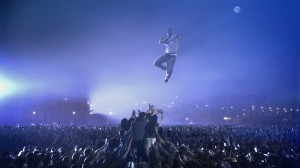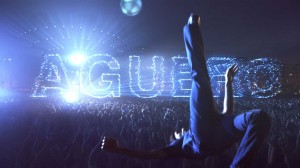
Framestore’s team of 20 VFX artists – spanning crowd specialists, Nuke compositors, roto artists, animators and technical directors – worked across the production for four months in order to deliver the commercial’s demanding and complex VFX while meeting the clients’ high expectations. In the words of David Foulds, PepsiCo International’s vice president advertising, “To say that we are delighted with the final product would be an understatement.”
The company created a new proprietary crowd system in order to fulfill the commercial’s massive scale. The system, developed by Diarmid Harrison-Murray and Martin Aufinger, was built in Side Effects Software’s Houdini using mo-cap data captured at Framestore’s in-house motion capture facility.
The crowd system is specifically designed to meet the needs of commercial projects. It allows a more efficient shot turnaround and gives the artist greater control over the crowd’s behavior and look, down to details such as outfit, hairstyle, props and more. Using Houdini’s native renderer, Mantra, allowed artists to set up agents quicker and use more complex lighting techniques on selected parts of the crowd while still being able to render thousands of background people within the same setup.
Framestore’s new crowd system allows shots to be laid out quickly using an instancing approach, without having to simulate each agent separately. This meant VFX artists could show the director many iterations of the crowd layout in a relatively short time.
Once the rough layout is approved, it is then possible to split off parts of the crowd that required certain behaviors, adding more layers of sophistication, in this case taking it to a level of detail where hands could dynamically grab the players’ feet and even hold flashing camera phones.
 This custom-built system became invaluable for creating realistic looking scenes.
This custom-built system became invaluable for creating realistic looking scenes.
“The fun part of a crowd job is when you suddenly notice unusually strange, almost disturbing behavior of one or two agents of a CG crowd,” explained Aufinger. “Luckily, we were easily able to quickly eliminate those offending agents!”
By merging the ability to layout a crowd quickly with a technique that enabled pinpointing of individual sections for specific types of animations, the end results looked authentic, but were created with an efficiency that gave Framestore’s team more time to focus on improving more relevant parts of shots.
One key advantage of this approach over shooting live-action crowd plates is that the lighting and atmosphere enveloping the crowd could be altered at any stage of the post process.
As a result, this system has now become Framestore’s de-facto crowd system for commercial projects and several other departments have already shown great interest in using it. The modular nature of the system means that additional features can be easily added as future projects require.
The project also gave Framestore’s 2D team – led by Chris Redding and Russell Dodgson – an array of challenges. A small-scale crew visited San Sebastian early in the process to capture high-resolution panoramic ‘dome’ images of the San Sebastian beach and to shoot the wide opening shot. These high-res location images were then projected onto an accurate topographical model of San Sebastian, extracted from Google Earth. This allowed the team to place a virtual camera anywhere on the beach and achieve realistic scale, perspective and defocus effects.
Due to the limited availability of the star players, the live-action elements were spread across three shoots in three different countries, supervised by Redding. Most of the live-action crowd elements, body doubles, Calvin Harris and his DJ stage were shot over six days in Romania. The players, with the exception of Messi, were shot at Shepperton Studios in England. Messi was filmed later in Barcelona.
In order to achieve the best result in matching live-action elements and CG crowd, the animation team roto-animated the players’ performances to be able to relight them in 3D. This approach also provided the freedom to create more dramatic lighting effects and make sure the heroes of the commercial stood out from the supporting crowd.
Another team was tasked with developing the laser letters that spell out the players’ names as they race across the crowd. After an initial brief from the director that referenced some prototype Japanese ionizing lasers, a small team began testing several approaches. The team used Houdini to develop the aesthetic seen in the finished spot.
Another team, using Autodesk Maya, handled a wide range of additional duties. These included creating the upper two thirds of the main stage, including rigging, moving light units, background cars, additional volumetric lights and even full CG face replacements for some of the players. The Maya team was also responsible for creating fully CG digital doubles of the players to replace almost all live-action body doubles in wider shots.





